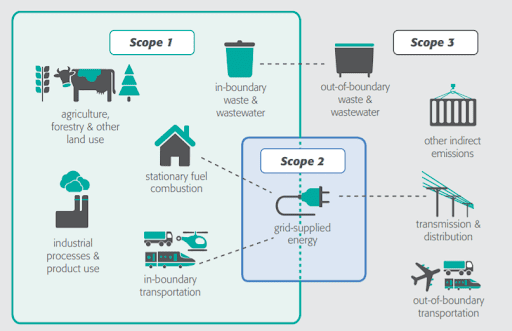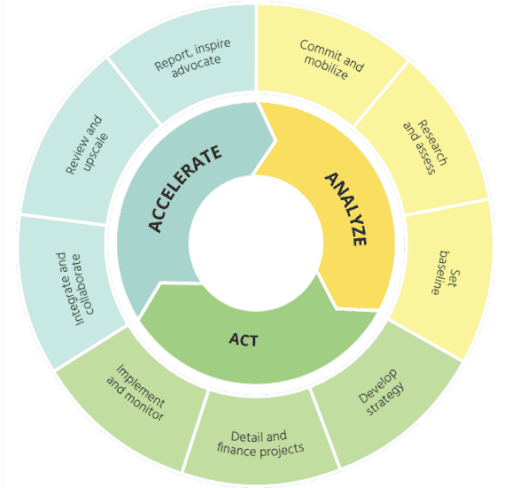Through the application of standardized methods and protocols, greenhouse gas (GHG) inventories calculate, quantify, and assess community associated emissions and their sources. Inventories can be conducted of emissions from a country; from the operations of an entity like a corporation, university or government; or for a local community. A community-scale inventory captures the emissions associated with activities happening within the geographic boundary of the community. Acting as a climate change balance sheet, GHG inventories show the progression and regression made and hold policy-makers and community members accountable to their verified goals and resolutions.
Common GHG sectors to track include transportation, stationary energy (residential, commercial, and industrial), and solid waste; some inventories also include industrial processes and product use, and agriculture, forestry, and land use. GHG inventories measure the output of internationally recognized GHGs from the above listed sectors. The three primary gasses include:

Communities and local governments conduct GHG inventories for various reasons, including:
- Managing GHG risks and identifying reduction opportunities
- Measuring progress towards local, regional, state, federal and international climate goals
- Identifying the largest GHG emitters within a boundary
- Informing the development of climate action plans
- Providing accountability to a community’s reduction goals
- Tracking GHG performance over time
- Creating a plan to reduce emissions
- Measuring annual reductions
- Motivating community action
- Allowing community stakeholders to see a comprehensive view of local emissions to guide decision making
- Recognizing GHG emissions performance relative to similar communities
- Enabling aggregation to GHG emissions data across regions
- Meeting reporting requirements
- Demonstrating compliance with regulations, mandatory or voluntary GHG programs, and market standards
- Achieving recognition and demonstrating leadership
GHG inventories are important because they are the fundamental preliminary step toward managing our local and international GHG emissions.
ICLEI’s Analyze, Act, Accelerate 3-phase, 9-step model outlines how climate risks and vulnerabilities can be assessed and identify solutions to integrate into urban development policies, plans, and processes. Inventories are integral to the Analyze phase, ultimately assessing changes in emissions and providing a baseline for accountability to reduction goals made within respective boundary limits. By conducting regular annual inventories over multiple analysis years, presenting data over time, local governments can report community trends related to their emission consumption.

Over the past years, there has been increasing interest in looking at the concept of a carbon budget. According to Carbon Transfer, a carbon budget is “the cumulative amount of carbon dioxide (CO2) emissions permitted over a period of time to keep within a certain temperature threshold”. For example, there is a specific limit to cumulative global emissions between now and 2050 that will most likely keep the temperature increase below 1.5 ℃. While it is possible for a community to calculate their own carbon budget based on this global limit, for simplicity ICLEI USA recommends using a Science Based Target (SBT), which will ensure that the community is on a pathway consistent with the global carbon budget for 1.5 ℃.
ICLEI USA’s recommended approach for SBTs combines the global carbon budget with a concept of fair share – recognizing that wealthy countries and those with higher per-capita emissions should reduce emissions more rapidly than lower income countries with low per-capita emissions. Using this approach, U.S. communities should aim to reduce per capita emissions by about 63% by 2030 and reduce emissions to zero by 2050. ICLEI USA can help determine the specific SBT for your community. In ICLEI USA’s Working Paper: Analysis of U.S. Local Government Science-Based Targets and Pathways to Achieve Them in the Race to Zero, the paper discusses the analysis, findings, and recommendations to achieve the realistic, yet, ambitious community SBT to hold global temperature increase to 1.5 ℃ by midcentury as outlined in the Paris Agreement.
Interested in becoming an ICLEI USA member? Learn more about membership here.
